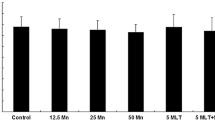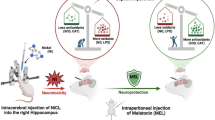Abstract
Excessive exposure to manganese (Mn) is associated with neurotoxicity characterized by oxidative stress, inflammation, and apoptosis induction. Selenium (Se) has been shown to possess antioxidant, anti-inflammatory, and anti-apoptotic properties in humans and animals. The present study investigated the neuroprotective mechanism of Se in rats sub-chronically treated with Mn at 30 mg/kg body weight or orally co-treated with Se at 0.2 and 0.4 mg/kg body weight for 35 consecutive days. Locomotive and exploratory profiles were recorded and computed with the aid of ANY-Maze (a video-tracking software) for 5-min trial, in a novel apparatus. The ANY-Maze analysis showed that Se significantly (p < 0.05) abated Mn-induced locomotive impairment evidenced by increased in maximum speed, total time traveled, absolute turn angle, number of line crossing, rotation and forelimb grip and decreased total time immobile, grooming, and negative geotaxis as verified by the enhanced track plot density. Furthermore, the striatum and hippocampus of the rats were excised and the levels of Mn and Se, oxidative stress markers, proinflammatory cytokines including acetylcholinesterase and caspase-3 activities were assayed. The result shows that Se abates Mn-mediated accumulation of Mn. Also, Se ameliorated Mn-induced decrease in antioxidant enzymes as well as glutathione level and increase in acetylcholinesterase activity, lipid peroxidation, proinflammatory cytokines (i.e., interleukin (IL)-6, IL-1β, tumor necrosis factor alpha), and caspase-3 activation in the striatum and hippocampus of the rats. Collectively, Se abated Mn-induced striatal and hippocampal toxicity via abrogation of neurobehavioral deficits, biometal accumulation, oxidative stress, inflammation, and caspase-3 activation in rats. Se may serve as a neuroprotective agent against Mn-mediated neurotoxicity.










Similar content being viewed by others
References
Aschner JL, Aschner M (2005) Nutritional aspects of manganese homeostasis. Mol Aspects Med 26(4–5):353–362
Pfalzer AC, Bowman AB (2017) Relationship between essential manganese toxicity in neurological disease. Currr Environ Health Rep 4:223–228
Tusch K, Mills PB, Peter T, Clayton PT (2013) Manganese and the brain. Inter Rev Neurobiol 110:278–302
Martinez-Finley EJ, Gavin CE, Aschner M, Gunter TE (2013) Manganese neurotoxicity and the role of reactive oxygen species. Free Radic Biol Med 62:65–75
Cordova F, Aguiar A Jr, Peres T, Lopes M, Goncalves F, Pedro D, Lopes S, Pilati C, Prediger RS, Farina M, Erikson K, Aschner M, Leal R (2013) Manganese-exposed developing rats display motor deficits and striatal oxidative stress that are reversed by Trolox. Arch Toxicol 87(7):1231–1244
Sidoryk-Wegrzynowicz M, Lee E, Albrecht J, Aschner M (2009) Manganese disrupts astrocyte glutamine transporter expression and function. J Neurochem 110:822–830
Filipov NM, Dodd CA (2012) Role of glial cells in manganese neurotoxicity. J Appl Toxicol 32(5):310–317
Moreno JA, Sullivan KA, Carbone DL, Hanneman WH, Tjalkens RB (2008) Manganese potentiates nuclear factor-κb-dependent expression of nitric oxide synthase 2 in astrocytes by activating soluble guanylate cyclase and extracellular responsive kinase signaling pathways. J Neurosci Res 8699:2028–2038
Nkpaa KW, Amadi BA, Wegwu MO, Farombi EO (2019a) Ethanol increases manganese-induced spatial learning and memory deficits via oxidative/nitrosative stress induced p53 dependent/independent hippocampal apoptosis. Toxicol 418:51–61
Nkpaa KW, Onyeso GI, Kponee KZ (2019b) Rutin abrogates manganese–induced striatal and hippocampal toxicity via inhibition of iron depletion, oxidative stress, inflammation and suppressing the NF-κB signaling pathway. J of Trace Elem in Med Biol 53:8–15
Hatfield DL, Tsuji PA, Carlson BA, Gladyshev VN (2014) Selenium and selenocysteine: roles in cancer, health, and development. Trends Biochem Sci 39:112e120
Vinceti M, Filippini T, Cilloni S, Bargellini A, Vergoni AV, Tsatsakis A, Ferrante M (2017) Health risk assessment of environmental selenium: emerging evidence and challenges (Review). Mol Med Rep 15:3323e3335
Fairweather-Tait SJ, Bao Y, Broadley MR, Collings R, Ford D, Hesketh JE, Hurst R (2011) Selenium in human health and disease. Antioxidants Redox Signal 14:1337e1383
Mehdi Y, Hornick J-L, Istasse L, Dufrasne I (2013) Selenium in the environment, metabolism and involvement in body functions. Molecules 18:3292–3311
Ren F, Chen X, Hesketh J, Gan F, Huang K (2012) Selenium promotes T-cell response to TCRstimulation and ConA, but not PHA in primary porcine splenocytes. PLoS One 7:e35375
Labunskyy VM, Hatfield DL, Gladyshev VN (2014) Selenoproteins: molecular pathways and physiological roles. Physiol Rev 94:739e777
Rayman MP, Rayman MP (2002) The argument for increasing selenium intake. Proc Nutr Soc 61:203–215
Mitchell JH, Nicol F, Beckett GJ, Arthur JR (1998) Selenoprotein expression and brain development in preweaning selenium- and iodine-deficient rats. J Mol Endocrinol 20:203–210
Festing MF, Altman DG (2002) Guidelines for the design and statistical analysis of experiments using laboratory animals. Institute for Laboratory Animal Research. ILAR J 43:244–258
Tawfik KM, Moustafa YM (2018) Neuroprotective mechanisms of sildenafil and selenium in PTZ-kindling model: implications in epilepsy. Eur J Pharmacol 833:131–144
Adedara IA, Abolaji AO, Idris UF, Olabiyi BF, Onibiyo EM, Ojuade TD, Farombi EO (2017) Neuroprotective influence of taurine on fluoride-induced biochemical and behavioral deficits in rats. Chem Biol Interact 261:1–10
Bradford MM (1976) Rapid and sensitive method for the quantitation of microgram quantities of protein utilizing the principle of protein-dye binding. Anal Biochem 72:248254
Misra HP, Fridovich I (1972) The role of superoxide anion in the autooxidation of epinephrine and a simple assay for superoxide dismutase. J, Biol Chem 247:3170–3175
Clairborne A (1995) Catalase activity. In: Greewald AR (ed) Handbook of methods for oxygen radical research. CRC Press, Boca Raton, FL, pp 37–242
Rotruck JT, Pope AL, Ganther HE, Swanson AB, Hafeman DG, Hoekstra WG (1973) Selenium: biochemical role as a component of glutathione peroxidase. Science 179:588–590
Beutler E, Duron O, Kelly BM (1963) Improved method for the determination of blood glutathione. J Lab Clin Med 61:882–888
Farombi EO, Tahnteng JG, Agboola AO, Nwankwo JO, Emerole GO (2000) Chemoprevention of 2-acetylaminofluorene-induced hepatotoxicity and lipid peroxidation in rats by kolaviron-a Garcinia kola seed extract. Food Chem Toxicol 38:535–541
Ellman G, Courtney KD, Andres V Jr, Feather-Stone RM (1961) A new and rapid colorimetric determination of acetylcholinesterase activity. Biochem Pharmacol 7:88–95
Wormley DD, Ramesh A, Hood DB (2004) Environmental contaminant-mixture effects on CNS development, plasticity, and behavior. Toxicol Appl Pharmacol 197:49–65
Malenka RC, Nestler EJ, Hyman SE (2009) Sydor A, Brown RY, eds. Molecular neuropharmacology: a foundation for clinical neuroscience (2nd ed.). New York: McGraw-Hill Medical. 147–148, 321, 367, 376.
Bharti VK, Srivastava RS, Anand AK, Kusum K (2012) Buffalo (Bubalus bubalis) epiphyseal proteins give protection from arsenic and fluoride-induced adverse changes in acetylcholinesterase activity in rats. J Biochem Mol Toxicol 26:10–15
Akinrinade ID, Memudu AE, Ogundele OM (2015) Fluoride and aluminium disturb neuronal morphology, transport functions, cholinesterase, lysosomal and cell cycle activities. Pathophysiology 22:105–115
Podhorna J, Brown RE (2000) Flibanserin has anxiolytic effects without locomotor side effects in the infant rat ultrasonic vocalization model of anxiety. Br J Pharmacol 130:739–746
Nkpaa KW, Amadi BA, Awogbindin IO, Abolaji AO, Adedara IA, Wegwu MO, Farombi EO (2018) Ethanol exacerbates manganese – induced neurobehavioral deficits, striatal oxidative stress and apoptosis via regulation of p53, caspase-3 and Bax/Bcl-2 ratio-dependent pathway in rat striatum. Biol Trace Elem Res 191:135–148
Peres TV, Schettinger MRC, Chen P, Carvalho F, Avila DS, Bowman AB, Aschner M (2016) Manganese-induced neurotoxicity: a review of its behavioral consequences and neuroprotective strategies. BMC Pharmacol Toxicol 17:57
Day J, Damsma G, Fibiger HC (1991) Cholinergic activity in the rat hippocampus, cortex and striatum correlates with locomotor activity: an in vivo micro-dialysis study. Pharmacol Biochem Behav 38:723–729
Pepeu G, Giovannini MG (2004) Changes in acetylcholine extracellular levels during cognitive processes. Learn Mem 11:21–27
Richetti SK, Rosemberg DB, Ventura-Lima J, Monserrat JM, Bogo MR, Bonan CD (2011) Acetylcholinesterase activity and antioxidant capacity of zebrafish brain is altered by heavy metal exposure. Neurotoxicology 32:116–122
Chtourou Y, Fetoui H, Garoui EM, Zeghal N (2012) Improvement of cerebellum redox states and cholinergic functions contribute to the beneficial effects of silymarin against manganese induced neurotoxicity. Neurochem Res 37:469–479
Adedara IA, Owoeye O, Awogbindin IO, Ajayi BO, Rocha JBT, Farombi EO (2018a) Diphenyl diselenide abrogates brain oxidative injury and neurobehavioral deficits associated with pesticide chlorpyrifos exposure in rats. Chem Biol Interact 296:105–116
Maldonado PD, Pérez-De La Cruz V, Torres-Ramos M, Silva-Islas C, Lecona-Vargas R, Lugo-Huitrón R, Blanco-Ayala T, Ugalde-Muñiz P, Vázquez-Cervantes GI, Fortoul TI, Ali SF, Santamaría A (2012) Selenium-induced antioxidant protection recruits’ modulation of thioredoxin reductase during excitotoxic/pro-oxidant events in the rat striatum. Neurochem Int 61(2):195–206
Adedara IA, Anao O, Forcados GE, Awogbidin IO, Agbowo A, Ola-Davies OE, Patlolla AK, Tchunwou PB, Farombi EO (2018b) Low doses of multi-walled carbon nanotubes elicit hepatotoxicity in rats with markers of oxidative stress and induction of pro-inflammatory cytokines. Biochem Biophys Res Commun 503(4):3167–3173
Parameswaran N, Partial S (2010) Tumor necrosis factor-α signaling in macrophages. Crit Rev Eukaryot Gene Expr 20(2):87–103
Pickering M, Cumiskey D (2005) O’Connor JJ (2005) Actions of TNF-α on glutamatergic synaptic transmission in the central nervous system. Exp Physiol 90(5):663–670
Porter AG, Janicke RU (1999) Emerging roles of caspase-3 in apoptosis. Cell Death Differ 6:99–104
Salvesen GS (2002) Caspases: opening the boxes and interpreting the arrows. Cell Death Differ 9(1):3–5
Weng C, Li Y, Xu D, Shi Y, Tang H (2005) Specific cleavage of Mcl-1 by caspase-3 in tumor necrosis factor-related apoptosis-inducing ligand (TRAIL)-induced apoptosis in Jurkat leukemia T cells. J Biol Chem 280(11):10491–10500
Zwolak I (2020) The role of selenium in arsenic and cadmium toxicity: an updated review of scientific literature. Biol Trace Elem Res 193:44–63
Author information
Authors and Affiliations
Corresponding author
Ethics declarations
Conflict of interest
The authors declare no competing interests.
Additional information
Publisher's note
Springer Nature remains neutral with regard to jurisdictional claims in published maps and institutional affiliations.
Rights and permissions
About this article
Cite this article
Nkpaa, K.W., Nkpaa, B.B., Amadi, B.A. et al. Selenium abates manganese–induced striatal and hippocampal toxicity via abrogation of neurobehavioral deficits, biometal accumulation, oxidative stress, inflammation, and caspase-3 activation in rats. Psychopharmacology 239, 399–412 (2022). https://doi.org/10.1007/s00213-021-06010-7
Received:
Accepted:
Published:
Issue Date:
DOI: https://doi.org/10.1007/s00213-021-06010-7




